Taxes are an integral part of our daily lives. They are more than just numbers you pay to the government; they are the foundation for building strong and sustainable societies. It is worth noting that understanding taxes is not only for accountants or economists, but rather an essential life skill for every individual who wants to control his money better. So whether you are a student, employee, or entrepreneur, gaining basic knowledge about taxes can save you a lot of money and time and help you avoid getting into legal problems. This guide will take you on an exciting journey to understand the basics of taxes in a simplified and transparent way, so that you can deal with them confidently and clearly.
A guide to understanding taxes for beginners
To understand taxes well, you must first understand what they are: The government imposes mandatory fees on individuals and companies to raise the necessary funds to finance their activities and public expenditures. It is a major tool for financing public services like education, health, infrastructure, and security. Payers do not receive direct or specific services or benefits in exchange, indicating a non-direct or proportional relationship between the tax and citizens’ benefits.
Tax concept
Simple definition
The government imposes a tax as a mandatory fee on individuals and companies to raise the necessary revenues to finance their public expenditures. People pay these fees without expecting a direct or specific benefit from the government in return.
Legal definition
Legally speaking, the state or local authorities impose a tax as a financial obligation on citizens and institutions, adhering to specific rules and laws. According to the definition of the Organization for Economic Co-operation and Development (OECD), taxes are obligatory payments imposed without a direct return in the form of services or goods.
Types of direct and indirect taxes in Saudi Arabia
To understand taxes, you must know that their types vary in the Kingdom of Saudi Arabia, including direct and indirect taxes, which aim to regulate the economy and generate financial resources for the state. These types are described below:
Direct taxes
Income tax
The income tax is one of Saudi Arabia’s most critical direct taxes. Individuals and institutions impose it on income resulting from their commercial activities. This tax includes:
Natural individuals who do not reside in Saudi Arabia: The Kingdom applies a 20% tax to their income from commercial activities.
Non-residents who carry out their activity in a permanent establishment are subject to the same 20% rate.
Non-resident individuals who receive income from sources within the Kingdom are subject to a 20% tax.
For those working in natural gas investment, the tax rate is 30%.
According to specific standards, a worker in oil and hydrocarbon production is subject to a tax rate ranging from 50% to 85%.
It is worth noting that the income tax rate increases with the increase in realized profits, as a percentage is deducted from profits exceeding a certain limit.
Corporate tax
It is also known as capital tax. To understand taxes, you must know that this tax amounts to 20% of the net profits of companies operating in the Kingdom. It is worth noting that they differ from those imposed on individuals, as they require special adjustments according to the type of activity and the revenues resulting from it.
Withholding tax
Non-residents who receive income or benefits from a person residing in the Kingdom are subject to a withholding tax. The non-resident is responsible for withholding a specific tax percentage and paying it to the Zakat Tax and Customs Authority. The percentage here ranges between 5% and 20%, depending on the nature of the payments.
Indirect taxes
Indirect taxes are imposed on goods and services that are not visible to the consumer because they are added to the final product’s price. Examples of these taxes include:
Value Added Tax (VAT)
Most goods and services in the Kingdom are subject to a value-added tax of 15%. To understand these taxes, you must know that they are paid by the final consumer and collected at multiple stages of production and distribution.
customs fees
It aims to protect local industries and regulate foreign trade by imposing it on goods imported into the Kingdom.
Excise tax
It is imposed on harmful goods, such as tobacco, soft drinks, and energy drinks, in varying proportions, up to 100%, to reduce consumption and protect public health.
How to calculate value-added tax
For you to understand value-added taxes and how to calculate them, there are two main methods:
Add the tax to the selling price.
This method is used when the selling price does not include tax. In this case, the tax is calculated by adding the tax percentage to the original selling price. The following formulas can be used:
- Tax amount = (sale price * added tax rate)/100.
- Total amount = selling price + tax amount.
Excluding tax from the selling price
This method is used when the selling price includes value-added tax. Here, the added tax is calculated and excluded from the total price. The following formulas can be used:
- Added tax amount = (sale price * tax rate) / (100 + added tax rate).
- Total amount = (sale price * 100) / (100 + added tax percentage).
An example of VAT calculation
Let’s take an example of calculating value-added tax (VAT) at 15% with a sale amount of SAR 3,000 so you can understand these taxes more clearly.
First case
- Tax amount = 3000 * 15 * 100 = 450 Saudi riyals.
- Total amount = 3000 + 450 = 3450 Saudi riyals.
If the selling price without tax is 3000 riyals, the tax added to it will be 450 riyals. Therefore, the final price paid by the buyer is 3450 riyals.
The second case
- Added tax amount = (3000 * 15) \ (100 + 15) = 391.30 Saudi riyals.
- Total amount: (3000 * 100) / (100 + 15) = 2608.70 Saudi riyals.
If the declared selling price, including tax, is 3,000 riyals, the added tax amount is 391.30 riyals. Therefore, the net amount of the item without tax is 2608.70 riyals.
How is VAT calculated?
Type of Tax Rate Tax base tax
Outputs VAT on revenue (15%) 1000 150
Outputs Exports (0%) 1500
Outputs: Exempt (0%) 1000 0
Total output: 3500, 150 (1)
Input VAT on purchases (15%) -100 -15
Input Reverse Charge (15%) -1000 0
Total input: 1100 -15 (2)
Net tax payable (1) – (2) 135
How to calculate withholding tax
This tax is deducted from any non-resident person’s income from sources within the Kingdom. To calculate the withholding tax, you must first know the category to which the non-resident person belongs, as these categories determine the percentage of tax that is applied. It is worth noting that the calculation process is done in simple steps, namely:
- Determining the tax rate: Each category of non-resident individuals has a specific tax rate.
- Calculating the tax value: The tax rate is multiplied by the amount of profits or income that the person obtained from the Kingdom.
An example of withholding tax
To understand these taxes more clearly, let us assume that a non-resident consultant in the Kingdom of Saudi Arabia earns fees amounting to 15,000 Saudi riyals from his work in the Kingdom, and the tax rate applied to this category is 15%. So, let’s calculate the withholding tax due and the associated steps for this advisor:
- Determine the tax rate: 15%.
- Calculating the tax value: We multiply the tax rate by the fee amount.
- Withholding tax = 15,000 * 0.15 = 2,250 Saudi riyals.
- Calculating fees after deduction: We deduct the value of the tax from the total fees.
- His fees after deduction are 15,000 minus 2,250, or 12,750 Saudi riyals.
So, the withholding tax due on the consultant’s fees is 2,250 Saudi riyals, and after deducting this tax, his net fees will be 12,750 Saudi riyals.
How to calculate excise tax
To calculate the excise tax imposed on a specific product, you must first know the tax rate applied to that product. Once you know this, you can easily calculate the tax value using the following equation:
- Tax = tax rate * product cost.
Example of excise tax
We will assume that we are dealing with a pack of cigarettes whose price is 20 riyals, and the tax rate applied to it is 100%. So, to calculate the value of the excise tax imposed, we use the following equation:
- Tax = tax rate * product cost.
- Applying the example: applicable excise tax = 20 * 1.00 = 20 riyals.
To calculate the final selling price of a pack of cigarettes after adding the tax, we add the tax value to the price of the original product:
- Selling price, including tax, = product price + tax = 20 + 20 = 40 Saudi riyals.
This method allows us to calculate the total amount that the consumer will pay for a pack of cigarettes after the excise tax.
The role of the Qoyod program in recording and tax management
Qoyod plays a vital role in facilitating the recording and tax management process for business owners and accountants in the Kingdom of Saudi Arabia to facilitate beginners’ understanding of taxes by providing advanced accounting and electronic invoicing solutions. These solutions improve the efficiency of financial operations and compliance with tax laws, which reflects positively on businesses. Here are the most important points that distinguish Qoyod’s role in this field:
Track output and input tax.
The Qoyod platform enables companies to track output and input tax accurately for each tax rate. This accurate tracking makes it easier for companies to submit correct tax returns, reducing the possibility of errors and delays.
Create a tax return.
Qoyod provides the feature of automatically generating a tax return based on the information registered in the system. This feature saves companies the time and effort spent preparing tax returns manually and ensures that the returns are submitted on the specified dates without any hassle.
Compliance with local laws and regulations
Qoyod ensures that all tax procedures comply with local laws and regulations. This feature means that companies will not have to worry about legal compliance, as Qoyod monitors changes in tax legislation and updates the system accordingly, protecting companies from potential legal risks.
Tax return form
If you want to download this form, click here.
Conclusion
Understanding taxes is an urgent necessity for any individual seeking to achieve financial stability and personal growth, as the ability to deal with taxes intelligently and knowing the laws that govern them not only protects you from unpleasant surprises and financial fines but also opens up broad horizons for future financial planning and managing your money efficiently. This guide should enable you to make informed financial decisions, enhancing your ability to achieve your financial goals and enjoy financial independence. Remember that taxes are not just numbers paid annually but are part of an economic and social system that requires our conscious understanding and effective participation. So invest time in learning the basics and delving into the details, and take advantage of available resources and financial advisors when needed.
Make tax knowledge a part of your daily financial culture and use an effective accounting program, such as Qoyod, and you will achieve more financial successes and enjoy peace of mind in managing your money. It is worth noting that it also offers all its clients electronic invoice systems, as well as points of sale systems, warehouses, customers, etc., which makes it the best-integrated accounting program.
After we have provided you with a guide to understanding taxes for beginners, try Qoyod now for free for 14 days and tell everyone about this fantastic program.
Join our inspiring community! Subscribe to our LinkedIn page and Twitter to be the first to know about the latest articles and updates. An opportunity for learning and development in the world of accounting and finance. Don’t miss out, join us today!




